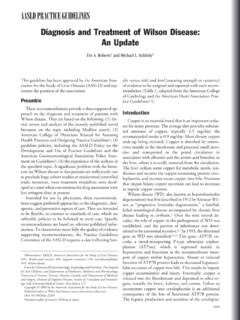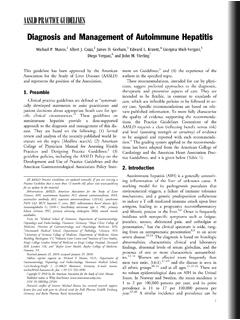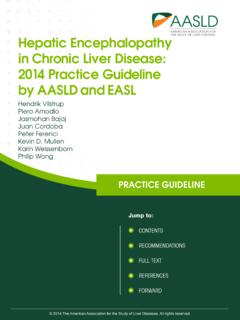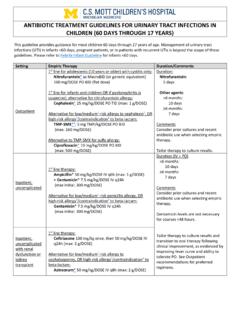Transcription of AASLD Guidelines for the Treatment of Hepatocellular …
1 AASLD Guidelines for the Treatmentof Hepatocellular CarcinomaJulie K. Heimbach,1 Laura M. Kulik,2 Richard S. Finn,3 Claude B. Sirlin,4 Michael M. Abecassis,5 Lewis R. Roberts,6 Andrew X. Zhu,7M. Hassan Murad,8and Jorge A. Marrero9 Guiding Principles andObjectivesGUIDING PRINCIPLESThis document presents official recommendationsof the American Association for the Study of LiverDiseases ( AASLD ) on the surveillance, diagnosis, andtreatment of Hepatocellular carcinoma (HCC) occur-ring in the setting of adults with cirrhosis. Unlike pre-vious AASLD practice Guidelines , the currentguideline was developed in compliance with the Insti-tute of Medicine standards for trustworthy practiceguidelines and uses the Grading of RecommendationAssessment, Development and Evaluation (GRADE)approach.
2 (1)Multiple systematic reviews of the litera-ture were conducted to support the recommendationsin this practice guideline. An enhanced understandingof the guideline can be obtained by reading the appli-cable portions of the systematic reviews. In addition,more detailed information may be found in the associ-ated guidance document related to clinically importantaspects of HCC that lacked sufficient evidence to war-rant a systematic guideline focuses on a broad spectrum of clinicalpractice, including surveillance of patients with cirrhosisfor HCC, establishing the diagnosis of HCC, and vari-ous therapeutic options for the Treatment of HCC. Toaddress other issues on HCC such as epidemiology, stag-ing, and additional aspects of diagnosis and Treatment ,the authors have created a new guidance document thatwill be published soon and is based upon the previousHCC AASLD Guidelines by Bruix and Sherman.
3 (2)KEY QUESTIONSThe guideline developers from the AASLD identi-fied key questions that health care providers are facedwith frequently in the evaluation and management ofpatients with HCC. These questions were:1. Should adults with cirrhosis undergo surveillancefor HCC? If so, which surveillance test is best?2. Should adults with cirrhosis and suspected HCCundergo diagnostic evaluation with multiphasicAbbreviations: AASLD , American Association for the Study of liver Diseases; AFP, alpha-fetoprotein; CI, confidence interval; CT, computed tomog-raphy; DEB-TACE, drug-eluting beads TACE; GRADE, Grading of Recommendation Assessment, Development and Evaluation; HAIC, hepaticarterial infusion chemotherapy; HCC, Hepatocellular carcinoma ; HBV, hepatitis B virus; HCV, hepatitis C virus; HR, hazard ratio; LRT, local-regional therapy; MELD, Model for End-Stage liver Disease; mRECIST, modified Response Evaluation Criteria in Solid Tumors; MRI, magneticresonance imaging; NAFLD, nonalcoholic fatty liver disease.
4 OPTN, Organ Procurement and Transplantation Network; OR, odds ratio; OS, overallsurvival; PEI, percutaneous ethanol injection; PVT, portal vein thrombosis; RCT, randomized controlled trial; RFA, radiofrequency ablation; RR,rel-ative risk; TACE, transarterial chemoembolization; TACI, transarterial chemoinfusion; TAE, transarterial embolization; TARE, transarterial radio-embolization; US, ultrasound; Y90, funding for the development of this Practice Guideline was provided by the American Association for the Study of liver Supporting Information may be found January 10, 2017; accepted January 10, by the American Association for the Study of liver this article online at conflict of interest: Laura M. Kulik is on the advisory board for Gilead, Bayer, Eisai, Salix, and Bristol-Myers Squibb.
5 Richard Finnconsults for Pfizer, Bayer, Novartis, Merck, and Bristol-Myers Squibb. Claude B. Sirlin consults for and has received grants from Virtualscopics. LewisR. Roberts consults for Wako, Medscape, and Axis; advises Tavec and Bayer; is on the speakers bureau for Onlive; and has received grants from Ariad,BTG, and Gilead. Andrew Zhu consults for Bristol-Myers Squibb, Eisai, Merck, Novartis, Sanofi, and GUIDELINE|HEPATOLOGY, VOL. 67, NO. 1, 2018 AHE STUDYOFLIVERD I S E ASESTMERICANASSOCIATIONFOR computed tomography (CT) or multiphasic mag-netic resonance imaging (MRI)?3. Should adults with cirrhosis and an indetermi-nate hepatic nodule undergo a biopsy, repeatedimaging, or alternative imaging for the diagnosticevaluation?4. Should adults with Child-Pugh class A cirrhosisand early-stage HCC (T1 or T2) be treated withresection or local-regional (LRT) therapy?
6 5. Should adults with cirrhosis and HCC that hasbeen resected or ablated successfully undergoadjuvant therapy?6. Should adults with cirrhosis awaiting liver trans-plantation and HCC (T1) be treated or undergoobservation?7. Should adults with cirrhosis and HCC (OrganProcurement and Transplantation Network[OPTN] T2) awaiting liver transplantationundergo transplantation alone or transplantationwith bridging therapy while waiting?8. Should adults with cirrhosis awaiting liver trans-plantation and HCC beyond Milan criteria (T3)undergo transplantation after being down-stagedto within Milan criteria?9. Should adults with cirrhosis and HCC (T2 orT3, no vascular involvement) who are not can-didates for resection or transplantation betreated with transarterial chemoembolization,transarterial radioembolization, or externalradiation?
7 10. Should adults with Child-Pugh class A/B cir-rhosis and advanced HCC with macrovascularinvasion and/or metastatic disease be treatedwith systemic or locoregional therapies or notherapy?TARGET AUDIENCEThis guideline is intended primarily for health careproviders who care for patients with cirrhosis. Addi-tionally, the guideline may inform policy decisionsregarding patients with OF DISEASEA ccording to the World Health Organization,HCC is the fifth most common tumor worldwide andthe second most common cause of cancer-related death( ). Male-to-female predominance is greater than 2:1with liver cancer, and approximately 83% of the estimat-ed 782,000 new HCC cases in 2012 occurred in lessdeveloped regions of the world, with East and SouthAsia plus sub-Saharan Africa being the regions of high-est incidence, Southern Europe and North Americabeing the regions of intermediate incidence, and North-ern Europe and South Central Asia being the regions oflowest incidence.
8 (3)The incidence of HCC has been rising rapidly in theUnited States over the last 20 years.(4)According to esti-mates from the Surveillance Epidemiology End Results(SEER) program of the National Cancer Institute, theUnited States will have witnessed an estimated 39,230cases of HCC and 27,170 HCC deaths in 2016 ( ). In addition, a recent study using theSEER registry projects that the incidence of HCC willcontinue to rise until 2030,(5)with the highest increase inHispanics, followed by African Americans and then Cau-casians, with a decrease noted among Asian INFORMATION:From the1 Division of Transplant Surgery, William J. von Liebig Transplant Center, Mayo Clinic, Rochester, MN;2 Department of Medi-cine, Division of Gastroenterology and Hepatology, Northwestern University, Chicago, IL;3 Department of Medicine, Division of Hema-tology and Oncology, David Geffen School of Medicine at the University of California, Los Angeles, Santa Monica Geffen School ofMedicine at UCLA, Los Angeles, California;4 liver Imaging Group, Department of Radiology, University of California, San Diego;5 Northwestern University Feinberg School of Medicine, Chicago, IL;6 Division of Gastroenterology and Hepatology, Mayo Clinic, Roches-ter, MN;7 Massachusetts General Hospital Cancer Center, Harvard Medical School, Boston, MA.
9 8 Mayo Clinic Evidence-based PracticeCenter, Mayo Clinic, Rochester, MN;9 Digestive and liver Diseases Division, Department of Internal Medicine, UT Southwestern Medi-cal Center, Dallas, CORRESPONDENCE AND REPRINT REQUESTS TO:Julie K. Heimbach, ClinicWilliam J. von Liebig Transplant CenterCharlton 10200 First Street SWRochester, MN 55905-0001E-mail: 507-266-6640 HEPATOLOGY, Vol. 67, No. 1, 2018 HEIMBACH ET increase in incidence of HCC in the United States isattributed primarily to the hepatitis C virus (HCV) epi-demic, prompting Petrick et al.(4)to suggest that preven-tive efforts should target the birth cohort with the highestprevalence of HCV infection (1945-1965). Recent datahave also shown that metabolic disorders defined asnonalcoholic fatty liver disease (NAFLD) and the meta-bolic syndrome contribute numerically more to the bur-den of HCC than any other risk factor including HCVinfection,(6)which is due primarily to the high prevalenceof NAFLD in the population GROUPThe presence of cirrhosis represents a key risk factorfor the development of HCC.
10 The prevalence of cir-rhosis among patients with HCC has been estimatedto be 85%-95%,(7,8)and the HCC incidence rateamong patients with cirrhosis has been shown to be2%-4% per year.(9)Therefore, patients with cirrhosisconstitute a high-risk group for efforts at preventionand early detection. The fact that patients with HCChave underlying liver disease impacts the managementand therapeutic options key questions posed above reflect common sce-narios in this patient population and provide the frame-work for this practice guideline. We used the Child-Pugh classification to define the underlying degree ofliver dysfunction instead of the Model for End-StageLiver Disease (MELD) classification, mainly because itis more commonly used in this of GuidelineDevelopmentAn experienced methodologist moderated and facil-itated the process of selecting the aforementioned keyTABLE 1.











